Schutztruppe
Schutztruppe (German: [ˈʃʊtsˌtʁʊpə] (![]()
| Schutztruppe | |
|---|---|
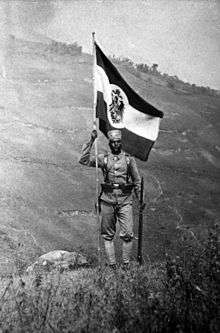 Schutztruppe Askari flag carrier, German East Africa, 1906 | |
| Active | 1891–1918 |
| Allegiance | |
| Type | Infantry |
| Size | 80,330 troops (including Seebataillon III (3rd Marine Battalion) and 200 camels |
| Engagements | Abushiri Revolt Adamawa campaign Herero Wars Herero and Namaqua Genocide World War I |
Military contingents were formed in German East Africa, where they became famous as Askari, in the Kamerun colony of German West Africa, and in German South-West Africa. Control of the German colonies of New Guinea, in Samoa, and in Togoland was performed by small local police detachments. Kiautschou in China under Imperial Navy administration was a notable exception. As part of the East Asian Station the navy garrisoned Tsingtao with the marines of Seebattaillon III, the only all-German unit with permanent status in an overseas protectorate.
Deployment
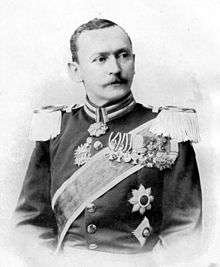
The name of the German colonial force dates back to the parlance of Chancellor Otto von Bismarck, who had the term Schutzgebiete, "protectorates", used instead of colonies. Schutztruppe contingents arose from local police forces or private paramilitary units, where German colonizers met with stronger resistance.
When in 1888 the Abushiri Revolt broke out in the dominions of the German East Africa Company, Bismarck's government in Berlin had to send mercenary troops under Reichskommissar Hermann Wissmann to subdue the uprising. Upon the establishment of German East Africa, these Wissmanntruppe were changed to Schutztruppe by an act of the Reichstag parliament on 22 March 1891. The police forces for South-West Africa under Curt von François and for German Cameroon were re-established as Schutztruppe by the act of 9 June 1895.
Schutztruppe formations under the supreme command of the German Emperor were organizationally never a part of the Imperial German Army, though German military law and discipline applied to its units. Initially supervised by the Imperial Navy Office, they were under the authority of the Colonial Department in the German Foreign Office by the act of 7 and 18 July 1896. In 1907 the Colonial Department with the Schutztruppe command was set up as the independent Imperial Colonial Office (Reichskolonialamt) agency directly answerable to the Chancellor of Germany.
In 1896 a central Schutztruppe command (Kommando der Schutztruppen) was established as part of the Colonial Department. Despite its name, this agency exercised no military leadership but served as an administrative authority. It was located at Berlin’s Mauerstrasse, in proximity to the Colonial Office. At the beginning of the First World War in 1914, there were three Schutztruppe military commands, one in each of the German colonial regions in East Africa, South-West Africa, and in Kamerun, subordinate to each governor.
German East Africa
- See also East African Campaign (World War I)
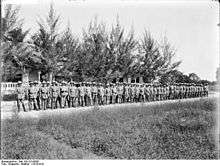
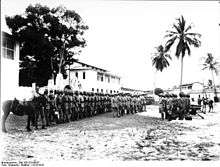
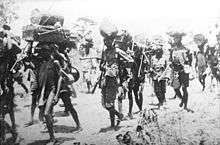
At the outbreak of the First World War, the Schutztruppe in German East Africa was organised into 14 field companies (Feldkompanien) with 2,500 men under arms, with headquarters at the capital Dar es Salaam. Including carriers and labourers, the force had about 14,000 personnel. On 13 April 1914, Lieutenant Colonel Paul Emil von Lettow-Vorbeck assumed command in German East Africa. He led his units throughout the First World War, eventually being promoted to Generalmajor.[2] The Schutztruppe in East Africa became the last German formation to surrender – days after the armistice in November 1918.
A pre-war company consisted of 160 (expandable to 200) men in three platoons (Züge) of 50 to 60 men each, including two machine-gun teams. Each of the 14 companies also had a minimum 250 man carrier contingent as well as native irregulars known as Ruga-Ruga of approximately the same size units.[3]
- 1st Company (Kompagnie: Arusha/Neu Moshi[4]
- 2nd Company: Iringa and Unbena
- 3rd Company: Lindi
- 4th Company: Kilimatinde and Singida
- 5th Company: Massoko
- 6th Company: Udjidiji and Kassulo
- 7th Company: Bukoba, Ussuwi and Kifumbiro
- 8th Company: Tabora
- 9th Company: Usumbura
- 10th Company: Dar es Salaam
- 11th Company: Kissenji and Mruhengeri
- 12th Company: Mahenge
- 13th Company: Kondoa Irangi
- 14th Company: Muansa and Ikoma
The Dar es Salaam garrison further included a recruitment depot, a signals department and quartermaster unit.
Overall strength was 300 European recruits and 2,472 Africans, specifically 68 combatant officers, 60 warrant officers and NCOs, 132 non-combatant medical officers, civilian administrators, ammunition technicians, and 2 African officers and 184 African NCOs and 2,286 Askari.[5][6]
During the First World War, companies numbered 15 through 30 were added, plus eight (A through H) temporary companies; and 1st through 8th Schützenkompagnies [rifle companies]. The Schützenkompagnies were originally composed of white settlers, their sons, plantations administrators and trading company employees but some units became racially mixed as the war dragged on. Numerous other small detachments were also formed. Several Reserve Kompagnien were also raised consisting of older Askari, they were prefixed by the letter "R".[7]
German Southwest Africa
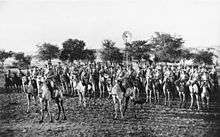
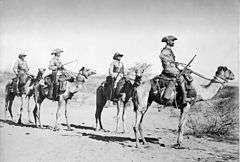
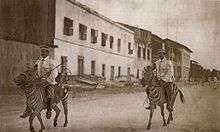
The Schutztruppe in German Southwest Africa was structured in 12 companies of mounted infantry totalling 1,500 men, primarily Germans. The 7th Company, stationed in the northern desert area of the colony, was mounted on imported camels. A single unit, called the Baster Company of non-local Africans was raised and deployed. Relations between the German administration and the natives in this colony had deteriorated to the point that few local Africans were recruited; Boers and Afrikaners did join to renew their fight against Great Britain.
The colonial forces for German Southwest Africa consisted of volunteers from the imperial army and navy (including some Austrians) but essentially consisted of members of German regiments. Before their deployment to Africa these troops were prepared for their special tasks and future environment. Such a training base was at Karlsruhe. Because of the often humid conditions in the upper Rhine valley of the grand-duchy of Baden, the area provided some early acclimatisation.
The structure of the Southwest African forces was as follows:
German Southwest Africa Command at Windhuk (modern Windhoek) consisted of headquarters, administration and legal (judge advocate), medical corps, surveying and mapping units.
Northern district command: Windhuk
- 1st Company: Regenstein, Seeis
- 4th Company: Okanjande
- 6th Company: Outjo and Otavi
- 2nd Battery: Johann-Albrechts-Höhe
- Transport platoon 1: Karibib
- Office for provisions: Karibib
- Horse depot: Okawayo
- Artillery and train depot: Windhuk
- Military hospital and medical depot: Windhuk
- Clothing depot: Windhuk
- Local headquarters: Windhuk
- Local headquarters and quartermaster: Swakopmund
Southern district command: Keetmanshoop
- 2nd Company: Ukamas
- 3rd Company: Kanus
- 5th Company: Chamis and Churutabis
- 7th and 8th Company (camel cavalry), military hospital: Gochas and Arahoab
- 1st Battery: Narubis
- 3rd Battery: Gibeon
- Transport platoon 2: Keetmanshoop
- Artillery and train depot: Keetmanshoop
- Military hospital and medical depot: Keetmanshoop
- Clothing depot: Keetmanshoop
- Office for provisions: Keetmanshoop
- Garrison administration: Keetmanshoop
- Horse depot: Aus
- Camel stud farm: Kalkfontain
- Local headquarters and quartermaster: Lüderitz
At the outbreak of the war the force had a total strength of 91 officers, 22 physicians, 9 veterinarians, 59 civilian administrators, ammunition technicians, 342 NCOs and 1,444 German other ranks for a total of 1,967 personnel.[8]
German West Africa
Kamerun
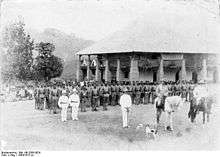
German West Africa encompassed two colonial entities, Kamerun and Togoland.
The Kamerun force in 1914 consisted of 12 companies, totalling 1,600 men with headquarters at Soppo and established in 1894 from the existing police force (formed in 1891).
The structure of the Kamerun forces was as follows:
Central Command: Soppo near the capital Buea[9]
- 1st Company (headquarters company) and artillery detachment: Duala
- 2nd Company: Bamenda, Wum and Kentu
- 3rd Company: Mora and Kusseri
- 4th Company: (expedition/survey company): Soppo
- 5th Company: Buar, Carnot and Ebolowa
- 6th Company: Mbaiki, Nola and Nguku
- 7th Company: Garua, Marua, Mubi
- 8th Company: Ngaundere
- 9th Company: Dume and Baturi
- 10th Company: Ojem and Mimwoul
- 11th Company: Akoafim and Minkebe
- 12th Company: Bumo, Fianga, and Gore
The companies were assigned to 49 garrisons in Kamerun and consisted of 61 officers, 23 physicians, 23 civilian administrators, ammunition technicians, 98 German NCOs and 1,650 African enlisted ranks for a total personnel count of 1,855.[9]
Togoland
Togoland had a total police force of 673 personnel deployed throughout the colony.[10] Approximately 1,000 troops were raised after the outbreak of the war. With few arms, ammunition or provisions, by the end of August 1914, all were forced to surrender to invading French and British forces.
Footnotes
- Gann, L. H.; Duignan, Peter (1977). The Rulers of German Africa, 1884–1914. Hoover Institution publications. Palo Alto: Stanford University Press. p. 116. ISBN 978-0-8047-0938-5.
- Hoyt, Guerilla, p. 175
- Miller, Battle for the Bundu, p. 18
- Haupt, p. 34, Schutztruppe garrisons
- Farwell, The Great War in Africa, p. 109
- McNab, Chris (2002). 20th Century Military Uniforms (2nd ed.). Kent: Grange Books. p. 89. ISBN 1-84013-476-3.
- Armies in East Africa 1914-1918 by Peter Abbot (Men-at-Arms 379) 2002 OspreyISBN 978-1-84176-489-4
- Haupt, Deutschlands Schutzgebiete , p. 56
- Haupt, p. 70
- Haupt, p. 79
Bibliography
- Farwell, Byron. The Great War in Africa, 1914–1918. New York: W. W. Norton & Company. 1989. ISBN 0-393-30564-3
- Haupt, Werner. Deutschlands Schutzgebiete in Übersee 1884–1918 [Germany’s Overseas Protectorates 1884-1918]. Friedberg: Podzun-Pallas Verlag. 1984. ISBN 3-7909-0204-7
- Hoyt, Edwin P. Guerilla. Colonel von Lettow-Vorbeck and Germany's East African Empire. New York: Macmillan Publishing Co., Inc. 1981; and London: Collier Macmillan Publishers. 1981. ISBN 0-02-555210-4.
- Miller, Charles. Battle for the Bundu: The First World War in German East Africa. London: Macdonald & Jane's, 1974; and New York: Macmillan Publishing Co., Inc. 1974. ISBN 0-02-584930-1.
Literature
- German Colonial Encyclopaedia, 1920, Volume III, p. 321ff.
- Kopf, Werner. The German colonial force 1889/1918, Dörfler Publishing House
- Morlang, Thomas. Askari und Fitafita. Farbige Söldner in den deutsche Kolonien. Berlin 2008
- Reith, Wolfgang. The Command Authorities of the Imperial Colonial Force in the Homeland. German Soldier Yearbook 2000 and 2001 (2 parts). Munich: Signal Publishing House.
External links
German language sites:
